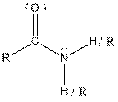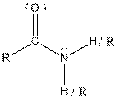
Concept explainers
(a)
Interpretation:
The following ball and stick model should be converted to skeletal or condensed formula and the

Concept Introduction:
Ball and stick model of molecule is determined by X-ray crystallography, in which the hydrogen atoms are depicted as white balls, carbon atoms as black balls and oxygen atom as red balls.
Organic molecules have some structural features in addition to
Table given below gives information about some common functional groups:
| Type of Compound | General Structure |
 | |
 | |
 | |
| Ester |  |
| Amide |  |
| Alcohol |  |
 | |
 | |
| Ether |  |
Here, R = any carbon backbone
(b)
Interpretation:
The following ball and stick model should be converted to skeletal or condensed formula and the functional groups present in the compound should be recognized:

Concept Introduction:
Ball and stick model of molecule is determined by X-ray crystallography, in which the hydrogen atoms are depicted as white balls, carbon atoms as black balls and oxygen atom as red balls.
Organic molecules have some structural features in addition to
Table given below gives information about some common functional groups:
| Type of Compound | General Structure |
| Aldehyde |  |
| Ketone |  |
| Carboxylic acid |  |
| Ester |  |
| Amide |  |
| Alcohol |  |
| Amine |  |
| Alkene |  |
Here, R = any carbon backbone
Want to see the full answer?
Check out a sample textbook solution
Chapter 11 Solutions
General, Organic, & Biological Chemistry
- Can I please get help with this?arrow_forwardUse the Henderson-Hasselbalch equation to calculate pH of a buffer containing 0.050M benzoic acidand 0.150M sodium benzoate. The Ka of benzoic acid is 6.5 x 10-5arrow_forwardA. Draw the structure of each of the following alcohols. Then draw and name the product you would expect to produce by the oxidation of each. a. 4-Methyl-2-heptanol b. 3,4-Dimethyl-1-pentanol c. 4-Ethyl-2-heptanol d. 5,7-Dichloro-3-heptanolarrow_forward
- What is the pH of a 1.0 L buffer made with 0.300 mol of HF (Ka = 6.8 × 10⁻⁴) and 0.200 mol of NaF to which 0.160 mol of NaOH were added?arrow_forwardCan I please get help with this.arrow_forwardDetermine if the following salt is neutral, acidic or basic. If acidic or basic, write the appropriate equilibrium equation for the acid or base that exists when the salt is dissolved in aqueous solution. If neutral, simply write only NR. Be sure to include the proper phases for all species within the reaction. N₂H₅ClO₄arrow_forward
 Introductory Chemistry: An Active Learning Approa...ChemistryISBN:9781305079250Author:Mark S. Cracolice, Ed PetersPublisher:Cengage Learning
Introductory Chemistry: An Active Learning Approa...ChemistryISBN:9781305079250Author:Mark S. Cracolice, Ed PetersPublisher:Cengage Learning Introductory Chemistry: A FoundationChemistryISBN:9781337399425Author:Steven S. Zumdahl, Donald J. DeCostePublisher:Cengage Learning
Introductory Chemistry: A FoundationChemistryISBN:9781337399425Author:Steven S. Zumdahl, Donald J. DeCostePublisher:Cengage Learning

